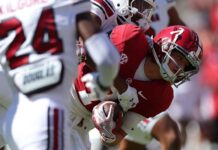[ad_1]
There was Autzen Stadium Oregon’s Noah Whittington was in a frenzy after bolting 100 yards on a kickoff return for what was supposed to be the game-tying, fourth-quarter touchdown against Boise State on Saturday night.
But as the Ducks were about to kick the extra point to make the score 34-34, referee Chris Coyette waved for a stoppage and turned on his microphone.
He said, the review of the drama is going on. “The runner may have let the ball go before crossing the goal line plane.”
gasp
Sure enough, replays showed Whittington committed one of football’s cardinal sins, leaving the ball shy of the end zone as he began to celebrate.
But within seconds, Coyote was back on the microphone with a confusing explanation: “After review, the ruling on the field has been affirmed,” he said. “It’s a touchdown.”
Initial replays on television broadcasts were incomplete. They showed Whittington dropping the ball but left out the next key element. Oregon’s Jayden Leamer, part of Whittington’s escort on the sideline, briefly ran past the fumbled ball, but he turned and scooped it up quickly to avoid a disaster of epic proportions. (He was officially credited with a 0-yard kickoff return for a touchdown.)
Near the sideline, Ducks coach Dan Lanning cycled through a gamut of emotions as anger turned to relief.
“Believe it or not, this is a situation that we coach a lot and obviously we don’t coach it well enough,” he said. “That ball should be in the end zone and given to the official. But I promise we’re going to coach really hard here.”
Dropping the ball before the end zone isn’t exactly an epidemic in college football, but it happens regularly enough — maybe a few times a season — to inspire collective fear across the country. Several coaches emphasized to ESPN this summer that it’s a real concern, and many of them address it regularly with their players throughout the year.
“I watch it on TV all the time, and I cringe because I haven’t been a part of it yet,” Kansas State coach Chris Kleiman said.
“Nevertheless,” as this embarrassing game always looks forward, ready to disrupt a football game at the most inopportune moment.
While Oregon fans Hearing Coyote’s reasons for stopping the game Saturday, it was natural for them to recall perhaps the most consequential act of “dropping the ball before the end zone” in college football history.
In fact, it’s a safe bet many people looked at the person next to them and asked, “Did he just pull a Kellyn Clay?”
On November 8, 2014, No. 4 Oregon visited No. 17 Utah for a game that will have postseason implications in the first season of the College Football Playoff. The Ducks (8-1) are led by eventual Heisman Trophy winner Marcus Mariota and must avoid a second loss to stay in the playoff mix.
Utah went up 7–0, and on the first play of the second quarter, quarterback Travis Wilson hit Clay on a deep pass and he ran 79-yards for the game-changing score. Fireworks went off in the stadium and for 15 seconds, the TV broadcast focused on the celebration and awkwardly transitioned to an aerial shot of Oregon’s Joe Walker running the other way with the ball.
4:11
Before the Utah WR drops the ball and scores, Oregon returns it
Travis Wilson completed a 78-yard pass to Kaelin Clay, but Clay was fumbled just before scoring. Oregon DB Eric Durgan recovered the ball and fumbled, and LB Joe Walker returned it 100 yards for a TD.
Walker was on the 15-yard line before broadcaster Brad Nestler spoke for everyone, “What’s going on out here on the field?”
Clay’s fumble was intercepted on live television shots, but replays showed he released the football before crossing the plane. Oregon’s Eric Durgan initially attempted to pick it up before Walker took possession and — in one of the most heads-up plays of all time — turned a 14-point deficit into a tie game.
It’s impossible to say how things would have gone had Utah gone ahead 14-0, but the Ducks quickly built on their good fortune and built a 24-7 second-quarter lead before going on to win 51-27.
“Obviously, a huge turn of events on the fumble going into the end zone,” Oregon coach Mark Helfrich said at the time. “A great lesson for all of us.”
Oregon would win its next three games to clinch the Pac-12 title and the No. 2 seed in the playoffs, defeating Florida State before losing to Ohio State in the title game.
For Utah, it’s a moment that lives in infamy.
“It’s something you definitely teach and practice and drill and hope it never happens, especially in a game, but it has,” Utah coach Kyle Whittingham said. “And Kailyn’s a football player; she felt worse about it than anybody. So it’s one of those things that happens on very, very rare occasions.”
Whittingham is one of many coaches who instructs his players not only to cross the goal line and hand the ball to the official — a fail-safe way to prevent a repeat — but also to pick up any loose balls when they are played. in question
Last year against Washington, the Huskies led 33-28 when Alfonzo Tuputala intercepted then-Utah quarterback Bryson Burns and returned it 76 yards for a score. It was similar to the Clay play where the television broadcast showed fans celebrating, flashing a “pick-six” graphic and updating the scoreboard to read 39-28.
But, again, replay revealed the premature celebration and Utah’s Michael Mokofisi appeared to run 10 yards out for cover at the 1-yard line.
At least on the one hand, lesson learned.
Patron saint The most high-profile example of this unique concentration is former NFL receiver DeSean Jackson’s premature touchdown celebration, whose fumble at the 1-yard line against the Dallas Cowboys as a rookie for the Philadelphia Eagles in 2008.
It’s a moment that might make someone say, “Well, you know he’ll never make that kind of mistake again.”
Except in Jackson’s case, it wasn’t his first time. A few years ago, in the Army All-American high school football game, Jackson broke free for an easy score before vaulting himself from the 5-yard line in an attempt to flip into the end zone. He came up shy of a yard and a half and pushed the ball.
It’s Jackson’s volatility in the NFL, though, that’s gotten the most mileage for coaches as they try to guard against repeated gaffes. Compilation videos are easy to find on YouTube, and trainers have created their own cutups that often feature Jackson as a prime example of what not to do.
“He did it in high school and in the pros, so we showed all of that to make sure our guys learn from other people,” Texas Tech coach Joey McGuire said. “It’s a deal, like scoring a football, handing the football over to the official and then celebrating with your teammates. That’s what we really try to do.”
Lessons don’t always stick.
In 2021, Louisville receiver Ahmari Huggins-Bruce turned a short completion into a 95-yard score, but coach Scott Satterfield immediately noticed that the officials were not treating it as a touchdown.
“I was, like, ‘What’s going on?’ And they told me, ‘Coach, he dropped the ball,'” Satterfield said.
It was largely forgotten as part of a 30-3 win over Eastern Kentucky, but not by Satterfield.
“Every August — I mean each August — We show our players film about that particular play because we’ve seen it,” he said. “Whether it’s a Leon Lett situation where Don Beebe runs and knocks the ball away or in this case a guy who lets it go too early, we try to show that. I do So, that’s the only thing that happened to me, but man, it’s a bad feeling.”
At TCU, coach Sonny Dykes has made a habit of showing a compilation of about 10-12 clips from college and NFL games on Friday nights before games about what not to do. It’s mostly mental mistakes that can unnecessarily swing a game, and the three main ones are similar examples in Jackson’s tussle with the Eagles, Klay against Oregon and Cal’s win over Texas in 2016, when Dykes was coaching the Golden Bears.
With 1 minute, 22 seconds left and Cal leading 50-43, Vic Enway’s 55-yard touchdown run only allowed the 1 to enter the club’s premature celebration.
“Vic was like, ‘Yeah, I thought I scored,’ and that was really in style at the time,” Dykes said. “I think the guys wanted to get it over with as soon as possible and that was kind of the thing, but he didn’t mean anything by it.”
The game was scored a touchdown on the field only to be overturned on replay. However, the officiating crew ruled that because there was no immediate recovery by Texas, the Bears would take over where Enwar threw the ball. It was a controversial decision because a Texas player picked it up in the end zone before handing it off to an official.
“He handed it off to anybody who was around the game,” said Mike Diffie, the game’s referee and current coordinator of Mountain West officials. “If he had picked it up and started running the other way, maybe it could have been interpreted differently. But his body language showed he thought the play was over.”
Instead of a Texas touchback, Cal took a stand at the 1-yard line and knelt down the clock.
“(Texas coach) Charlie Strong was losing his mind,” Daffey said. “He felt like they should have gotten the ball. It was a big play, but it got to the point where I explained to him that the rules are very specific about how we handle it. It was loose and nothing was done with it.”
As this type of play has become a familiar phenomenon, working crews have also become more adept at spotting it in real time, although it’s not always immediately apparent.
“Those plays probably drive the coaches crazy,” Defy said. “It makes us mad because it puts us in a difficult situation, but I think for the young players, they think they’ve had a great game. They’re scoring goals. I think it causes them to lose focus on their vision, but it’s Creates another dimension for us.
“If we see the ball loose, of course we want to take responsibility. But if there’s not somebody we’re visibly picking up that’s trying to recover the ball, we’re going to give it a healthy two, three seconds or more. First we make the play. kill and then invoke the rule that covers it.”
even the best Coaching cannot prevent these fumbles.
What should have been a 79-yard touchdown for Alabama happened to a Nick Saban-led team last year. It happened to Bob Stoops’ Oklahoma team in 2016, though the officials missed it and Joe Mixon got away with it. (It seems a coincidence that both Hall of Fame coaches retired after that season.)
0:58
The Alabama QB drops the ball before it crosses the goal line
Ty Simpson broke free for the longest run by an Alabama QB in more than 20 seasons, but threw the ball just short of the goal line.
This happened with Dabo Swinney’s Clemson Tigers and Kirby Smart’s Georgia Bulldogs.
And as much as coaches teach it and fans scream at the television, it will almost certainly happen again.
In this case, players must pick themselves up (and, hopefully, the ball) and move on.
“It’s something we can learn from,” Lanning said, echoing Helfrich from 2014. “I think if you’re not learning as a coach and as a player, you’re not doing your job.”
Until then, coaches — unlike the players in that infamous moment — will refuse to let it go.
[ad_2]











